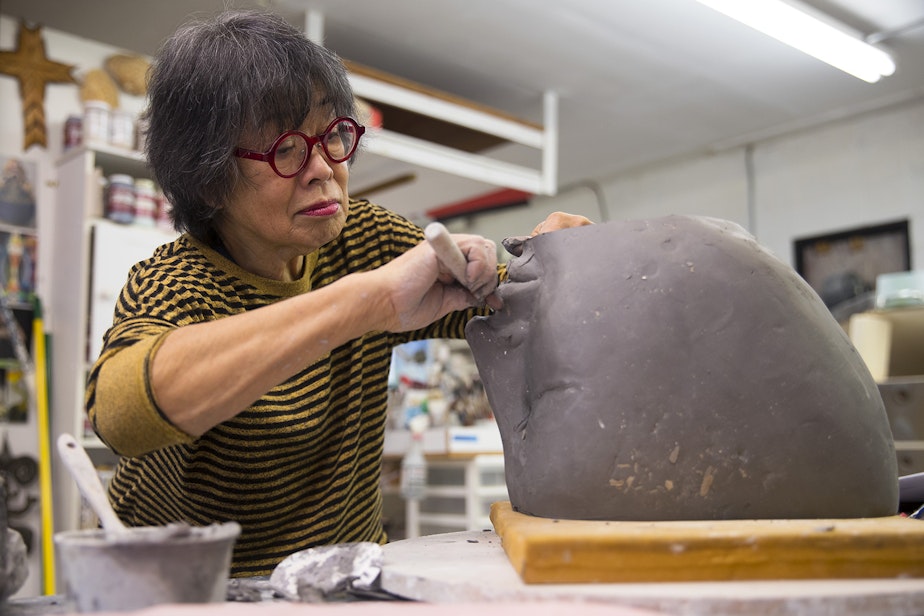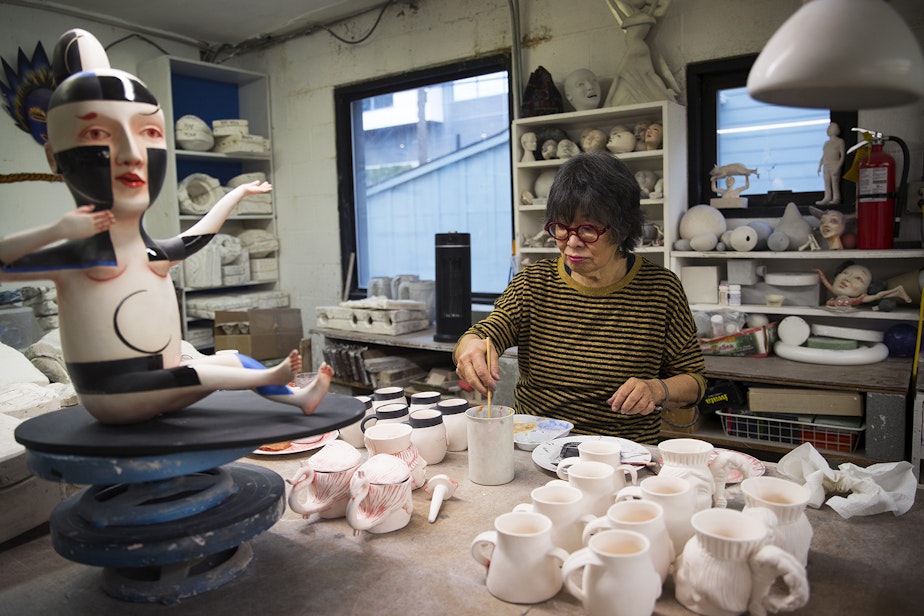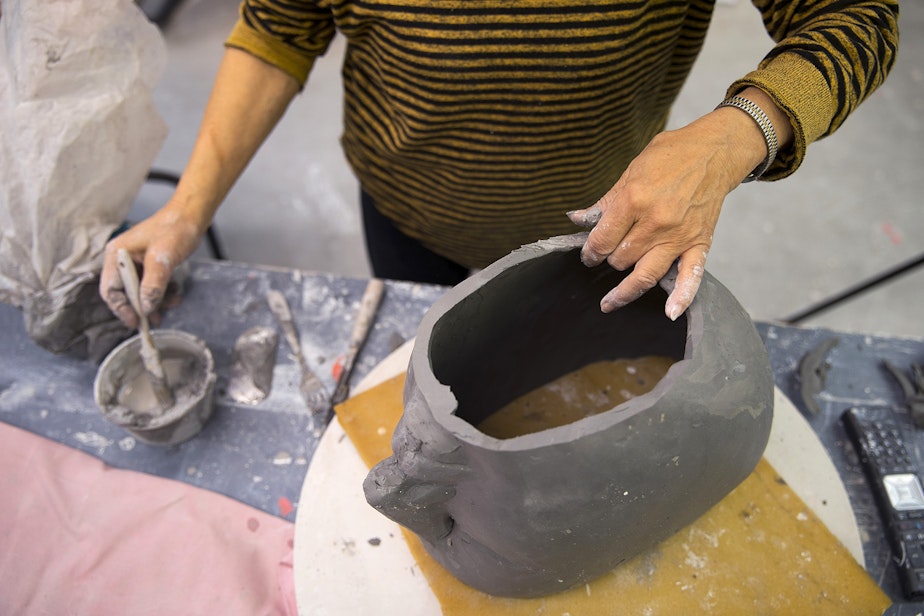She screamed so loud she scared off a rhino, and other Patti Warashina stories

Patti Warashina is a ceramic artist, but during the pandemic, she’s been drawing a lot -- pictures of herself drinking martinis, yelling at news coverage of President Trump, and kicking a giant, spiked coronavirus out of her house.
“He’s fleeing away from me,” she says with a laugh. “Because I’m worse than he is!”
Warashina is an international art star, showing work in museums and galleries around the world. But Covid-19 has kept her hunkered down in her Seattle home for the past three and a half months.
“It’s not that much different from being a studio artist,” Warashina says. “You spend a lot of time by yourself anyways, you know?”
Warashina’s bold drawings don’t surprise her good friend, curator Beth Sellars, who shares a similar story about the artist. The two women were traveling in India, and decided to do some birdwatching in a wildlife sanctuary there. They were standing at the edge of the road, their binoculars trained on the forest.
Sponsored
“All of a sudden, a rhino burst out of the bushes and headed straight for us,” Sellars says.
She and the guide leapt into their jeep as the rhino approached, but Warashina’s attention was focused on the birds, and she didn’t notice the rhino until he was about six feet from her. Sellars remembers her friend let out a scream.
Sponsored
“I have never heard a scream like that,” she says. “And apparently the rhino hadn’t either!”
The animal fled into the trees, apparently scared off by this grandmother who stands not much more than five feet tall.
Warashina’s ceramic art is equally fearless. Deceptively pretty from a distance, the porcelain sculptures are decorated with colorful societal and political commentary: North Korea’s Kim Jong Un clutching a missile, or Vladimir Putin as a smug cat watching Donald Trump throw a temper tantrum. Warashina’s home studio is dominated by two large work tables, two large kilns, and a television tuned to the latest news program.
“She works all day with the TV news on and gets more and more angry,” says Beth Sellars.

Sponsored
That hasn’t changed in the past few months, with, first, the pandemic, then the protests for racial justice. Warashina is no stranger to conversations about race. She grew up in Spokane, the youngest child of a Japanese-born dentist and a Japanese-American mom. Because they lived in Spokane during World War II, her family wasn’t interned in one of the West Coast camps. But they weren’t exactly free to go about their daily lives. Warashina was very young at that time, but she remembers federal agents searching her home. Luckily, they didn’t find the Japanese flag her father had stored in a trunk in the attic.
“We stopped speaking Japanese at home after that,” she says.
In 1958, Warashina came to Seattle to attend the University of Washington. Her older sister urged her to study dental hygiene, but Warashina fell in love with studio art, specifically with clay. Eventually she earned a masters in fine arts from UW.
Warashina retired from her UW teaching job many years ago, but she still works at a breakneck pace, even when scheduled gallery openings, museum exhibitions and other art-world events have been postponed. She jokes that with the stay-at-home orders, she doesn’t have to worry about appointments or social get-togethers: she can spend all day and night in her studio.
Warashina’s dedication is common among older career artists, according to neuroscientist Daniel Levitin, author of the book “Successful Aging.” He says an enduring curiosity about the world is a key component of staying both physically and mentally healthy as we age.
Sponsored
“People who have a strong will to explore and to try new things; they’re the ones who tend to do better in life," Levitin says.
Warashina has spent the past few months of pandemic lockdown trying to figure out how to sculpt a huge, hollow ceramic head, kind of like a bucket. She wants to fill it with clay figures and depictions of episodes from her long life. She imagines them exploding out of the bucket, but she hasn’t figured out how to make that happen.

The physics are daunting, but Warashina never lets a challenge stop her; in fact she welcomes them, unafraid to make a mistake or look foolish.
Daniel Levitin says that’s a hallmark of our aging brains: the self-censor function actually starts to shrink away.
Sponsored
“The devil on your shoulder saying you’re no good,” Levitin says. “You clear that away and you open up creativity.”
And that doesn’t pertain only to artists. In a world where we face both an ongoing pandemic, and a mass movement to confront institutional racism, we’re all learning new ways to think outside the box; whether that means figuring out new ways to work with clay or to deploy our police force.
Warashina is watching events unfold from the safety of her Seattle home, with a sense of wonder at the rapid rate of the change.
“The multi-cultural crowds are a testament to how universal the outrage is,” she says. “It’s caught on globally, on a profound scale.
“Thank God.”




